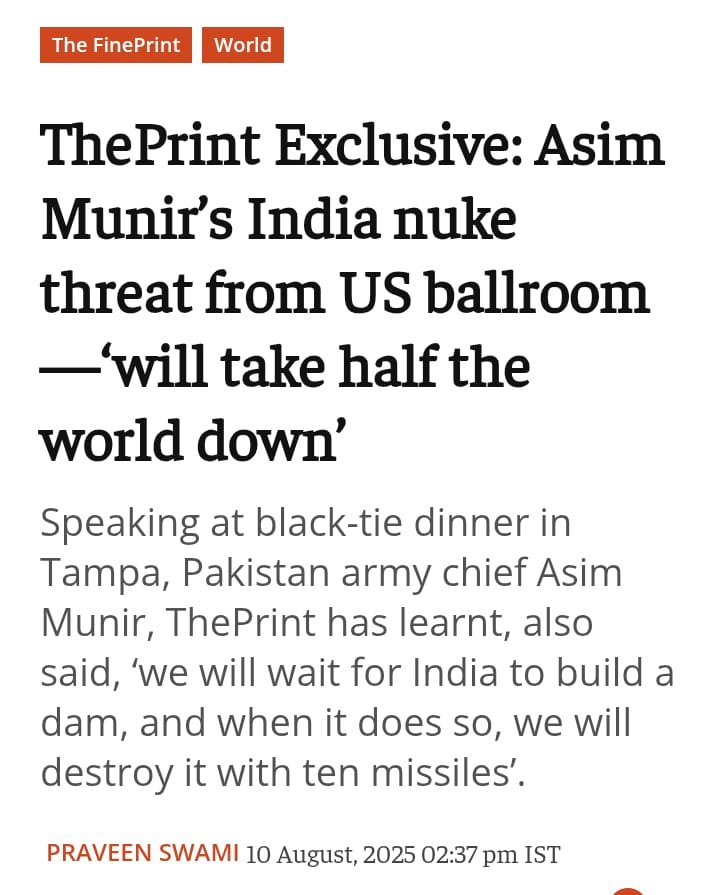Field Marshal Asim Munir’s black-tie address in Tampa was meant for the Pakistani diaspora — a reminder of homeland duty, resilience, and resolve. Yet, across the border, it has triggered a familiar storm in India’s media circles, particularly in The Print, which framed it as a dangerous “nuclear threat from US soil.”
1. The Indian Obsession: From Border Fences to Ballroom Dinner Tables
In the words of The Print, Munir “threatened to plunge the region into nuclear war… saying ‘we are a nuclear nation, if we think we are going down, we’ll take half the world down with us.’”
Let’s pause here — Pakistan’s nuclear doctrine has always been about credible deterrence in the face of existential threats. This is not a new position, yet Indian media paints it as an unprecedented escalation because Munir’s profile unsettles them. He is neither apologetic nor constrained by the diplomatic caution they expect.
You May Like To Read: PsyOps in Counterterrorism
Indian journalists reconstructed this speech “from the memory of several participants” — no transcripts, no recordings. This isn’t evidence; it’s narrative manufacturing. And in that manufactured space, India’s media finds room to insert fear-mongering while erasing strategic context.

Source: Print India
2. Why India Is Crying: The Geopolitics Behind the Noise
Beyond the headlines, the real discomfort for India is that Munir’s US engagements — from attending General Kurilla’s retirement to a reported meeting with Donald Trump — project Pakistan as a confident, relevant player in Washington’s strategic circles.
The Print notes with unease that Munir “had controversially been invited to meet with US President Donald Trump… no invitation has yet been extended to its [Pakistan’s] Prime Minister or President.” That sentence betrays more than it reports — it’s less about Pakistan’s civil-military optics and more about India’s frustration that the man shaping Pakistan’s foreign posture is being heard at high tables they cannot fully control.
Asim Munir is doing a great job for his Islamic Pakistan to be respected by the Western world including the Islamic nations. He speaks in English and vows to fight for his country with values of string Islam. This is unlike the weak, coward and corrupt Hindu Administration that… pic.twitter.com/nlXoaZU6AN
— Akshay Gupta (@AkshayJiGupta) August 11, 2025
3. India’s Propaganda Reflex: Lessons They Never Learn
Consider this The Print flourish: “Salad, soup and bombs” — a trivialising tagline that reduces a serious diaspora address to a punchline. The intent? To frame the evening as theatrical bravado rather than strategic signalling.
Other loaded framing follows: Munir’s remark on water rights is paraphrased as “We will wait for India to build a dam, and when it does so, phir 10 missile sey faarigh kar dengey.” Here, the Hindi-Urdu quote is used not for authenticity but for emotional effect — to play into the Indian public’s appetite for the ‘aggressive Pakistani general’ trope.
You May Like To Read: FIA’s New Anti-Theft Apps Secure Citizens Online
Yet, the strategic point remains buried: Pakistan will defend its lifeline rivers under the Indus Waters Treaty framework, and India’s unilateral suspension of clauses threatens millions with water insecurity. That part, of course, doesn’t make the headline.
ThePrint Exclusive: Asim Munir’s India nuke threat from US ballroom—‘will take half the world down’
Praveen Swami @praveenswami reports #ThePrintExclusivehttps://t.co/7bvumWQZrY
— ThePrintIndia (@ThePrintIndia) August 10, 2025
4. The Real Message Behind the Tampa Address
Beneath the theatrical packaging, the Tampa speech was a mix of deterrence reaffirmation, diaspora mobilisation, and historical-religious framing:
- “The Indus river is not the Indians’ family property… Humein missilon ki kami nahin hai, al-Hamdulillah” — a clear reminder that Pakistan’s defence capacity is intact.
- “Kisi ki maa kaali ho sakti hai, aur kisi ki dharti-maa kaali ho sakti hai, par maa maa hoti hai” — a poetic metaphor to stress patriotism above superficial differences.
- References to Pakistan as “one of only two states founded on the basis of the Kalimah” — tying national survival to ideological destiny.
By weaving faith, military metaphors, and blunt geopolitics, Munir spoke to his diaspora’s sense of identity and agency, something Indian media cannot digest without ridicule.

Discourse Framing Table: The Print vs. The Strategic Reality
| The Print’s Framing | Actual Strategic Message |
| “Threatened to plunge the region into nuclear war… ‘we are a nuclear nation… we’ll take half the world down with us.’” | Restatement of Pakistan’s long-held nuclear deterrence doctrine — survival against existential threats, not a first-strike threat. |
| “We will wait for India to build a dam… destroy it with ten missiles.” | An assertion that Pakistan will defend its water rights under the Indus Waters Treaty if India unilaterally violates it. |
| “Salad, soup and bombs” | Deliberate trivialisation of a formal diaspora event to distract from its serious strategic content. |
| “Invited to meet Donald Trump… no invitation to PM or President” | Elevation of Pakistan’s military diplomacy profile in Washington, signalling strategic relevance. |
| “Mocked India’s refusal to provide details of its losses” | Call for transparency on both sides after the Four-Day War, exposing India’s reluctance to reveal battlefield realities. |
| Hindi-Urdu quotes highlighted for dramatic effect | Use of cultural idioms to connect with the diaspora audience, not to threaten India theatrically. |
5. Why This Moment Matters for Pakistan’s Global Standing
The Tampa address, stripped of India’s performative outrage, is part of a wider rebranding of Pakistan’s international posture — not as a supplicant but as a state with strategic clarity and resilience.
India’s loud reaction is less about the words and more about the optics: Pakistan’s top general engaging directly with US strategic circles while India grapples with its own diplomatic friction with Washington.
And so, the noise will continue. Because in the quiet rooms where power truly shifts, Pakistan just had its say — and the world, inconveniently for India, was listening.







